A piece of crypto-mining malware is using sophisticated tools for its operations, including a Windows exploit linked to the National Security Agency, security researchers warn.
Dubbed WannaMine, the crypto-mining worm spreads using EternalBlue, the NSA-linked tool that became public in April 2017, just one month after Microsoft released a patch for it.
Leveraging a vulnerability in Windows’ Server Message Block (SMB) on port 445, the exploit became famous after the WannaCry ransomware was found exploiting it for distribution. Other malware families abused it as well, including botnets, backdoors, NotPetya, and banking Trojans.
Now, the same exploit is being used to spread WannaMine, a piece of malware focused on mining for the Monero crypto-currency, but which uses sophisticated capabilities, such as persistence and distribution mechanisms similar to those used by nation-state actors, CrowdStrike says.
WannaMine, the security researchers explain, employs “living off the land” techniques for persistence, such as Windows Management Instrumentation (WMI) permanent event subscriptions. The malware has a fileless nature, leveraging PowerShell for infection, which makes it difficult to block without the appropriate security tools.
The malware uses credential harvester Mimikatz to acquire legitimate credentials that would allow it to propagate and move laterally. If that fails, however, the worm attempts to exploit the remote system via EternalBlue.
To achieve persistence, WannaMine sets a permanent event subscription that would execute a PowerShell command located in the Event Consumer every 90 minutes.
The malware targets all Windows versions starting with Windows 2000, including 64-bit versions and Windows Server 2003. However, it uses different files and commands for Windows Vista and newer platform iterations.
“While the tactics, techniques, and procedures (TTPs) displayed in WannaMine did not require a high degree of sophistication, the attack clearly stands on the shoulders of more innovative and enterprising nation-state and eCrime threat actors. CrowdStrike anticipates that these threat actors will continue to evolve their capabilities to go undetected,” the security company notes.
As Sophos points out, organizations that find the WannaMine malware in their network are also at risk of other malware, including ransomware. It is not uncommon to find multiple malware families on machines that have been compromised once.
Designed to mine for Monero, not to steal user information or crypto-coins, WannaMine would still slow down the infected machines. Laptops could even be damaged, if the malware runs on them continuously for several hours, as the device gets hotter. Also, the battery is drained faster than usual, Sophos points out.
An antivirus application should keep users protected from this malware family. Keeping systems up to date at all times and using strong passwords should also help avoiding a WannaMine infection.
To read the original article:
http://www.securityweek.com/wannamine-malware-spreads-nsa-linked-exploit
